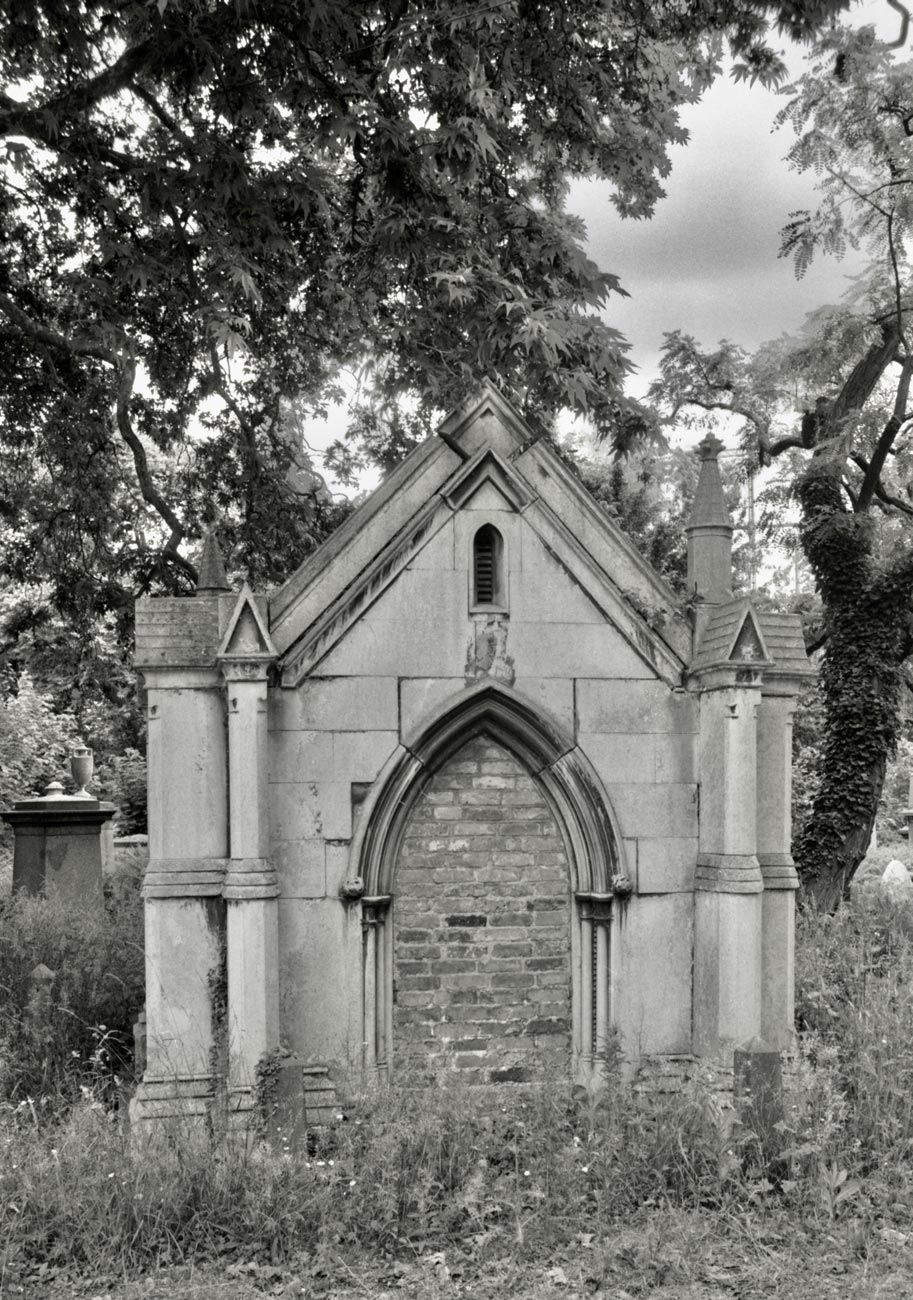A friend of Aaron managed to tow away his truck which needs a new fuel pump. He hopes to have it repaired as soon as possible.
On another very grey day I scanned more black and white negatives from May 2008 that didn’t appear in The Magnificent Seven publication.



The first selection is from Kensal Green cemetery, opened by The General Cemetery Company in 1833, the oldest of London’s landscaped cemeteries.
‘The Cemetery of All Souls at Kensal Green was the earliest of the large privately-run cemeteries established on the fringes of London to relieve pressure on overcrowded urban churchyards. Its founder George Frederick Carden intended it as an English counterpart to the great Père-Lachaise cemetery in Paris, which he had visited in 1821. In 1830, with the financial backing of the banker Sir John Dean Paul, Carden established the General Cemetery Company, and two years later an Act of Parliament was obtained to develop a 55-acre site at Kensal Green, then among open fields to the west of the metropolis. An architectural competition was held, but the winning entry – a Gothic scheme by HE Kendall – fell foul of Sir John’s classicising tastes, and the surveyor John Griffith of Finsbury was eventually employed both to lay out the grounds and to design the Greek Revival chapels, entrance arch and catacombs, which were built between 1834 and 1837. A sequence of royal burials, beginning in 1843 with that of Prince Augustus Frederick, Duke of Sussex, ensured the cemetery’s popularity. It is still administered by the General Cemetery Company, assisted since 1989 by the Friends of Kensal Green.’ (historicengland.org.uk)
This still working graveyard contains a number of family mausoleums, some of which are now bricked up.
This one is that of Andrew Ducrow (1793-1842)
‘This Graeco-Egyptian mausoleum, designed ostensibly for his wife, but mainly (as the epitaph says) “by genius for the reception of its own remains.” Condemned in The Builder in 1856 as a piece of “ponderous coxcombry. “
Ducrow was a circus stunt rider as well as the owner and producer of the wildly successful hippodramas, The Battle of Waterloo and Mazeppa. Note ……. the flanking sphinxes……… See also winged horse visible on left of relief. Other motifs included shells, beehives, angels etc.’
Caption and commentary by Jacqueline Banerjee 2007′. (http://www.victorianweb.org/art/parks/kensalgreen/13.html)
This memorial to Major General The Hon. Sir William Casement (1788-1844) ‘was’, according to collection.nam.ac.uk, ‘erected in Kensal Green Cemetery by his widow’. ‘He died of cholera at Cossipore (Cossipur or Kashipur) in 1844 shortly before he was due to return to England. Casement delayed his departure when he received a letter requesting him not to return, due to unrest in the Madras Army, that was signed by the members of the Supreme Council (the letter is in British Library). He is buried in Lower Circular Road Cemetery, Kolkata (Calcutta)’ There is, according to Historic England an identical monument in Kolkata. I remain confused about where his remains actually lie.

findagrave.com tells that the resident of the next monument, Sir Samuel Wilson, was ‘Pastoralist and owner of much land in Australia, author of “The Californian Salmon With an Account of its Introduction into Victoria”, Conservative MP for Portsmouth, he was knighted in 1875.’
‘Eustace Meredyth Martin (1816-92) [for whom this resting place was built] was a barrister, traveller and writer. His books include ‘A Tour through India in Lord Canning’s Time’ (1881), ‘A Visit to the Holy Land, Syria and Constantinople’ (1883), and a children’s novel entitled ‘Round the World'(1883)’ (historicengland.org.uk).
A group of Italian families a buried here.
Brompton Cemetery bears the grave of Flight-Sub-Lieut. Reginald Alexander John Warneford, V.C., R.N.A.S..
‘On 7 June 1915 at Ghent, Belgium, Warneford, flying a Morane-Saulnier Type L, attacked another German Army airship, LZ 37. He chased the airship from the coast near Ostend and, despite its defensive machine-gun fire, succeeded in dropping his bombs on it, the last of which set the airship on fire. LZ37 subsequently crashed in Sint-Amandsberg[a] (51°3′43.2″N 3°44′54.7″E).[8] The explosion overturned Warneford’s aircraft and stopped its engine. Having no alternative, Warneford had to land behind enemy lines, but after 35 minutes spent on repairs, he managed to restart the engine just as the Germans realized what was going on, and after yelling “Give my regards to the Kaiser!”, he was able to achieve liftoff and returned to base.[9][1]
On 17 June 1915, Warneford received the award of Légion d’honneur from the French Army Commander in Chief, General Joffre. Following a celebratory lunch, Warneford travelled to the aerodrome at Buc in order to ferry an aircraft for delivery to the RNAS at Veurne. Having made one short test flight, he then flew a second flight, carrying an American journalist, Henry Beach Needham, as passenger. During a climb to 200 feet, the righthand wings collapsed leading to a catastrophic failure of the airframe. Accounts suggest that neither occupant was harnessed and were both thrown out of the aircraft, suffering fatal injuries. In the case of Needham, death was instantaneous.’ (Wikipedia)
Just 10 days after he earned his V.C. This man died in a flying accident.
Beatrix Potter grew up in the nearby fashionable Kensington, and seemingly spent much of her childhood behind the walls of Brompton Cemetery where it is believed she found inspiration for her characters’ names on the gravestones,
one of which was suitable for a Squirrel.
This evening we dined on more of Jackie’s super-tasty beef and mushroom pie, this time with roast potatoes and parsnips; tender cabbage and runner beans; firm carrots and cauliflower, with thick, meaty, gravy. The Culinary Queen drank Hoegaarden and I finished the La Repasse.





